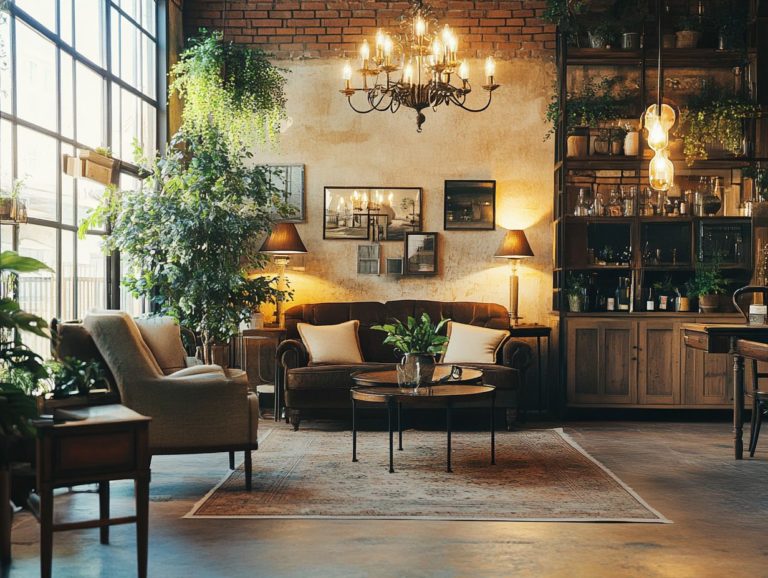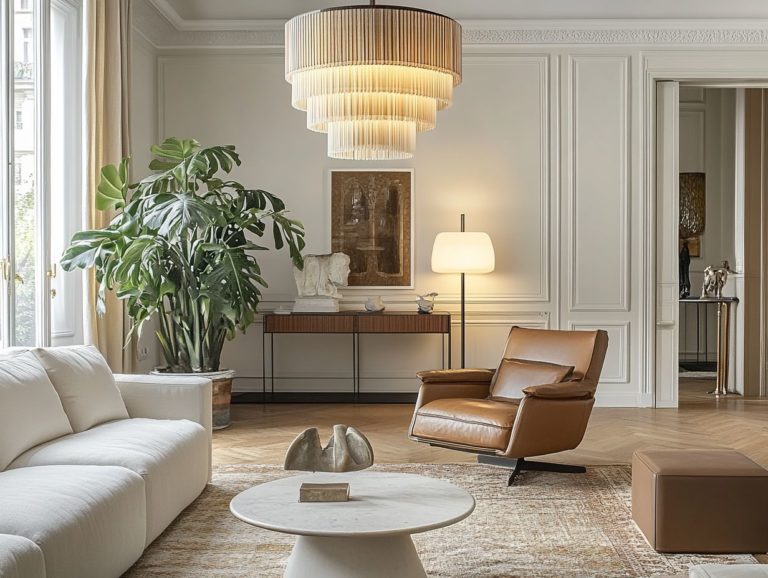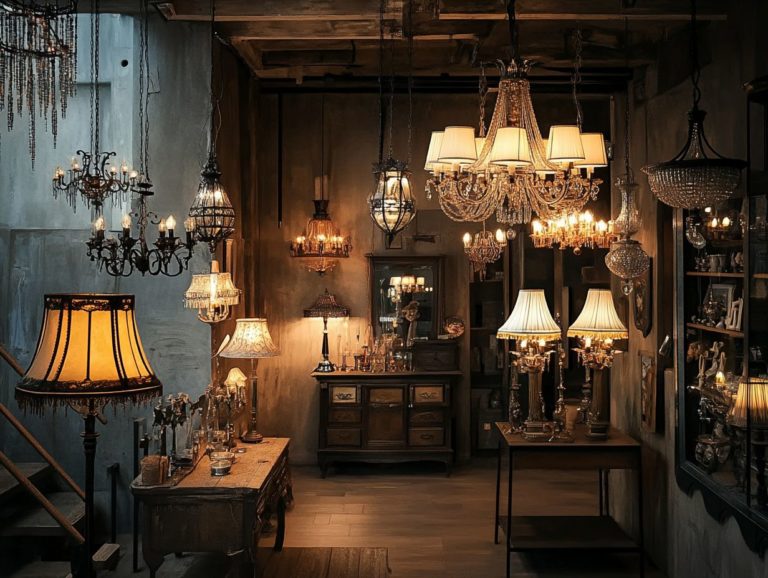Choosing the Right Shade for Your Vintage Lamp
Vintage lamps possess a distinctive charm, infusing any space with character and a touch of history. By selecting the perfect shade, you can elevate their beauty to new heights.
This article covers essential factors for choosing a shade. Consider the lamp’s style, size, lighting needs, and the type of shade like fabric, glass, or metal.
You will find tips for matching shades and maintaining them, ensuring that your vintage treasures continue to shine brilliantly for years to come.
Contents
- Key Takeaways:
- What Makes Vintage Lamps Special?
- Factors to Consider When Choosing a Shade
- Types of Lamp Shades
- Matching the Shade to the Lamp
- Tips for Finding the Perfect Match
- Maintaining and Cleaning Vintage Lamp Shades
- Proper Care and Cleaning Techniques
- Frequently Asked Questions
- What are some key factors to consider when choosing the right shade for your vintage lamp?
- What size shade should I choose for my vintage lamp?
- What shape of shade is best for a vintage lamp?
- What materials are commonly used for vintage lamp shades?
- Should I match the shade color to my vintage lamp?
- Can I mix and match different shades for my vintage lamp?
Key Takeaways:
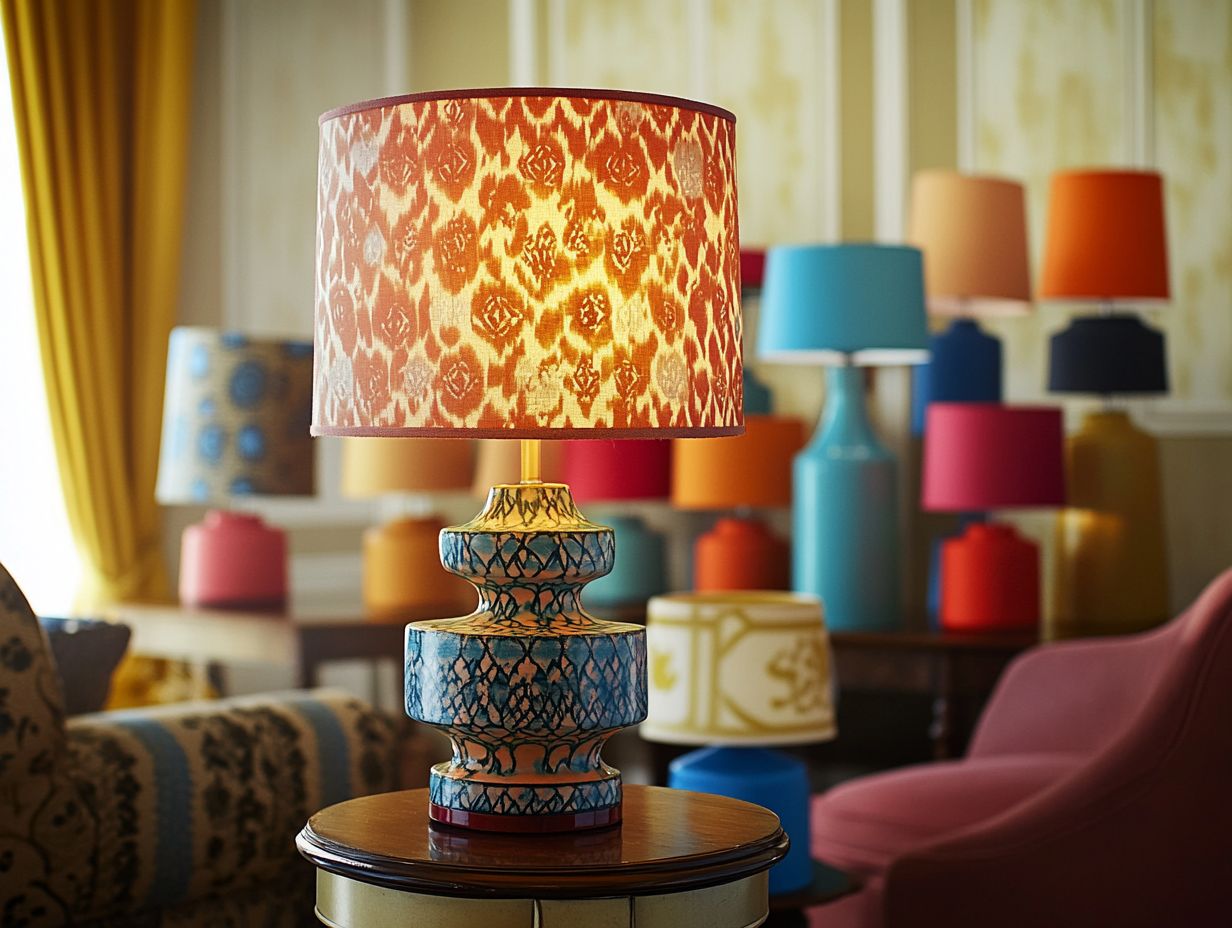
- Consider the style and era of your vintage lamp when choosing a shade to ensure a cohesive and authentic look.
- Remember to take into account the size and proportion of your lamp when selecting a shade for optimal lighting and visual balance.
- Utilize proper care and cleaning techniques to maintain the beauty and integrity of your vintage lamp shades.
What Makes Vintage Lamps Special?
Vintage lamps occupy a cherished spot in the hearts of homeowners and collectors alike, distinguished by their unique designs and the craftsmanship that often accompanies their creation. These lamps, whether they grace a tabletop or stand elegantly on the floor, transcend mere functionality; they emerge as artistic statements that embody the style, era, and trends of their time.
Every piece tells a captivating story, adorned with features like fabric shades, bell shades, and empire shades. Often discovered in antique shops or curated collections, these lamps highlight their historical significance. For those looking to enhance their workspace, choosing the right vintage lighting for your office can add a unique touch.
Factors to Consider When Choosing a Shade
When choosing the ideal lampshade for your lighting fixture, it s essential to consider several important factors to achieve a good match between the lamp base and the shade.
Key elements such as the size of the lampshade, its shape, and the material it s made from significantly impact both the look and usefulness of your lighting, whether you’re working with a table lamp or a floor lamp.
Each of these components influences not only the overall height and bottom diameter of the lamp but also how effectively it meets your specific lighting requirements.
Style and Era of the Lamp
The style and era of a lamp play a crucial role in shaping its aesthetic allure and practicality, guiding you toward the lampshades that will best enhance the lamp base.
Take, for example, a mid-century modern lamp with its clean lines and organic shapes; it beautifully pairs with a geometric fabric lampshade, highlighting its minimalist charm.
On the other hand, a Victorian-inspired lamp, adorned with intricate details and rich finishes, finds its perfect match in a luxurious silk shade, complete with tassels or fringes, adding an opulent touch.
Imagine a classic Tiffany lamp, famous for its stained glass and intricate designs; it truly shines when paired with a delicate, artful shade that amplifies its grandeur. For those drawn to contemporary designs, sleek, drum-shaped shades in muted tones reflect a refined approach, resonating with modern sensibilities. If you’re interested in enhancing your lighting choices, check out this guide on how to choose vintage light bulbs for the perfect finish.
Size and Proportion
Understanding the size and proportion of your lampshade is vital for achieving visual balance and harmony in your space.
When selecting a lampshade, a smart approach is to measure the height of your lamp, ensuring that the shade adequately covers the bulb without overshadowing the overall design. For a pleasing aesthetic, aim for the bottom diameter of the shade to be approximately one-third the height of the lamp.
Also, consider the style and colors of your furniture and decor; a thoughtfully chosen shade can seamlessly complement elements like a cozy sofa or vibrant artwork, effortlessly uniting the entire room.
Lighting Needs and Functionality
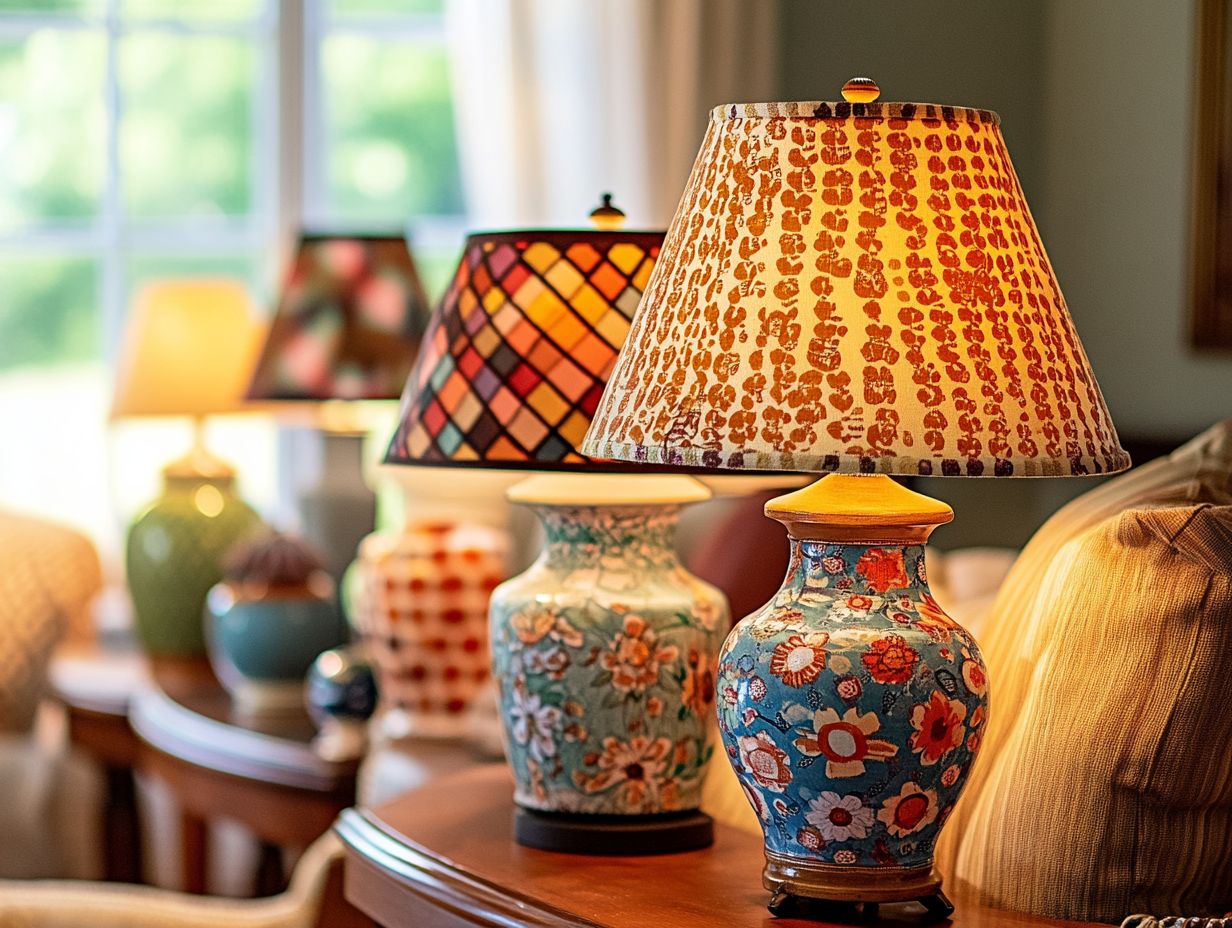
Evaluating your lighting needs and the intended functionality of your lamps is crucial when it comes to selecting the perfect lampshade.
Different shades can significantly influence how light is diffused throughout your space, ultimately shaping the overall ambiance. For table lamps, which often require directed illumination for tasks such as reading or working, lighter materials can provide that focused glow you’re after. On the other hand, darker or textured shades can create a softer, more diffused effect, perfect for a cozy vibe.
In terms of floor lamps designed for broader lighting, larger, wider shades are your best bet. They allow light to disperse evenly, enhancing the room’s atmosphere beautifully. Choosing the right material and design ensures each lamp works well in your lighting setup.
Types of Lamp Shades
Lamp shades present an array of types, each delivering unique looks and functions tailored to diverse lighting requirements and decor styles.
Fabric Shades
Fabric shades stand out as a premium choice for their impressive versatility, available in an array of luxurious textiles such as silk, cotton, linen, and velvet, each offering a unique aesthetic appeal.
These diverse fabrics don t just shape the overall design; they play a pivotal role in how light dances into your space, profoundly affecting the ambiance. For example, silk shades can cast a soft, warm glow that s perfect for those intimate gatherings, while cotton shades diffuse light evenly, making them well-suited for family rooms or creative studios.
Linen, with its textured finish, introduces a relaxed, organic vibe that effortlessly bridges contemporary and vintage styles. Meanwhile, the rich depth of velvet adds a touch of opulence, enhancing the elegance of traditional interiors making it an ideal choice for formal dining rooms or sophisticated lounges.
Each fabric creates a unique vibe that allows you to express your style!
Glass Shades
Glass shades present a modern and sophisticated alternative to traditional fabric options, offering a crystal-clear transparency that allows light to dance beautifully through your space.
These versatile lighting solutions come in an impressive array of styles, from frosted finishes that gently diffuse light to vibrant stained varieties that create dynamic lighting effects. By incorporating glass shades, you can effortlessly transform the ambiance of any room. For example, clear glass shades amplify brightness, while textured options introduce a touch of visual intrigue. Understanding how lighting affects vintage decor choices can further enhance your design approach.
Decorative glass choices, featuring etched patterns or artistic designs, serve a dual purpose: they provide essential lighting while also acting as captivating conversation starters. Glass shades blend functionality with charm, making them a great addition to any room.
Metal Shades
Metal shades are renowned for their durability and their ability to enhance industrial-style decor, making them a superb choice for both table lamps and floor lamps.
These versatile fixtures not only elevate the look of your space but also cater to a variety of design preferences, seamlessly fitting into both modern minimalist and charming vintage settings. With a range of finishes ranging from brushed nickel to matte black these shades can effortlessly transform any room.
Beyond their visual allure, metal shades require minimal maintenance and offer long-lasting durability, ensuring they withstand the test of time while remaining a striking focal point in your home. Their sturdy nature makes them perfect for high-traffic areas, proving that style can indeed coexist with functionality.
Matching the Shade to the Lamp
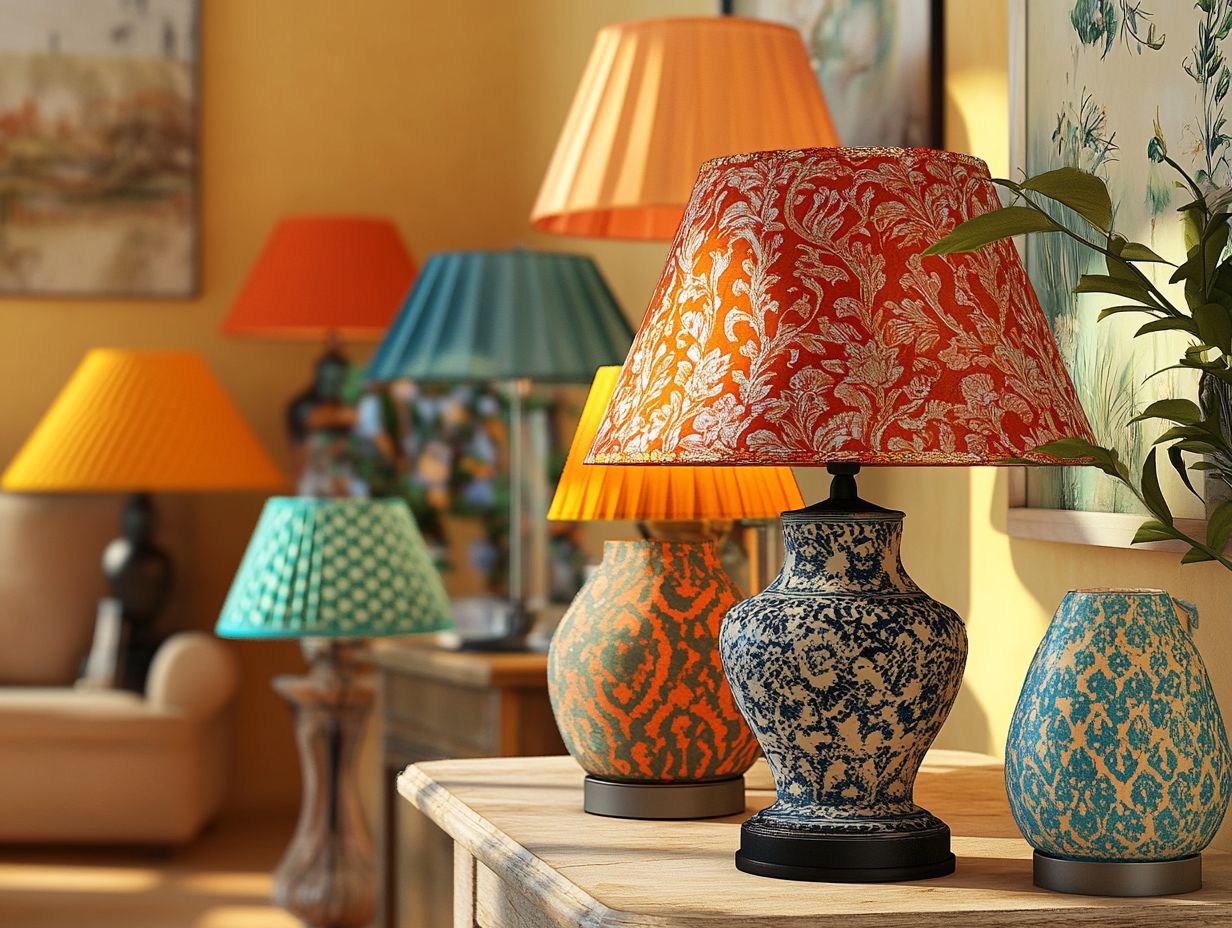
Achieving harmony between your lampshade and lamp base is essential for crafting a cohesive design that elevates your room’s aesthetic appeal. By carefully considering the interplay of textures, colors, and shapes, you can transform a simple lighting fixture into a striking focal point that complements your overall decor.
Explore the available shades to find your perfect match!
Tips for Finding the Perfect Match
Finding the perfect match between your lampshade and lamp base requires thoughtful consideration. Focus on several key factors for a harmonious design.
It s not merely about color. The pattern and size of the shade are vital in enhancing the overall aesthetic of your space. When selecting shades, envision how the hue complements both the lamp base and the surrounding decor.
For instance, a vibrant geometric pattern can inject a sense of fun and modernity into a simple, understated lamp. A soft, solid color can create an elegant, cohesive look in a more traditional setting.
Don t overlook the size. An oversized shade can become a striking focal point in a spacious room. A smaller one might be just right for snug corners or intimate spaces.
Mixing and matching varied heights and materials can lead to captivating combinations that truly elevate your interior design.
Maintaining and Cleaning Vintage Lamp Shades
Proper maintenance and cleaning of vintage lamp shades, including fabric shades, are vital for preserving their beauty and functionality over time.
By taking these steps, you ensure they continue to be a cherished element of your decor, whether as a table lamp or a floor lamp.
Proper Care and Cleaning Techniques
Understanding the proper care and cleaning techniques for various lamp shades, such as drum shades or bell shades, is essential for maintaining their look and function. By employing the right cleaning methods, your fabric, glass, and metal shades will not only look pristine but also last significantly longer.
For fabric shades, a gentle vacuuming with a brush attachment is your best bet for removing dust without causing any damage to the material. If you encounter stains on your silk lampshade, spot cleaning with a mild detergent is advisable. Additionally, if you’re looking to elevate your decor, consider finding the perfect vintage lamp shade to complement your space.
For glass shades, a mixture of warm water and vinegar will give you that streak-free shine, making them ideal for a chic chandelier (a decorative hanging light). For metal shades, simply wipe them down with a soft cloth and a suitable cleaner, steering clear of abrasive materials that could scratch their surface.
Regular maintenance enhances the visual appeal of your lampshades and prevents buildup that could impact their functionality, especially for shades with a larger bottom diameter.
Frequently Asked Questions
What are some key factors to consider when choosing the right shade for your vintage lamp?
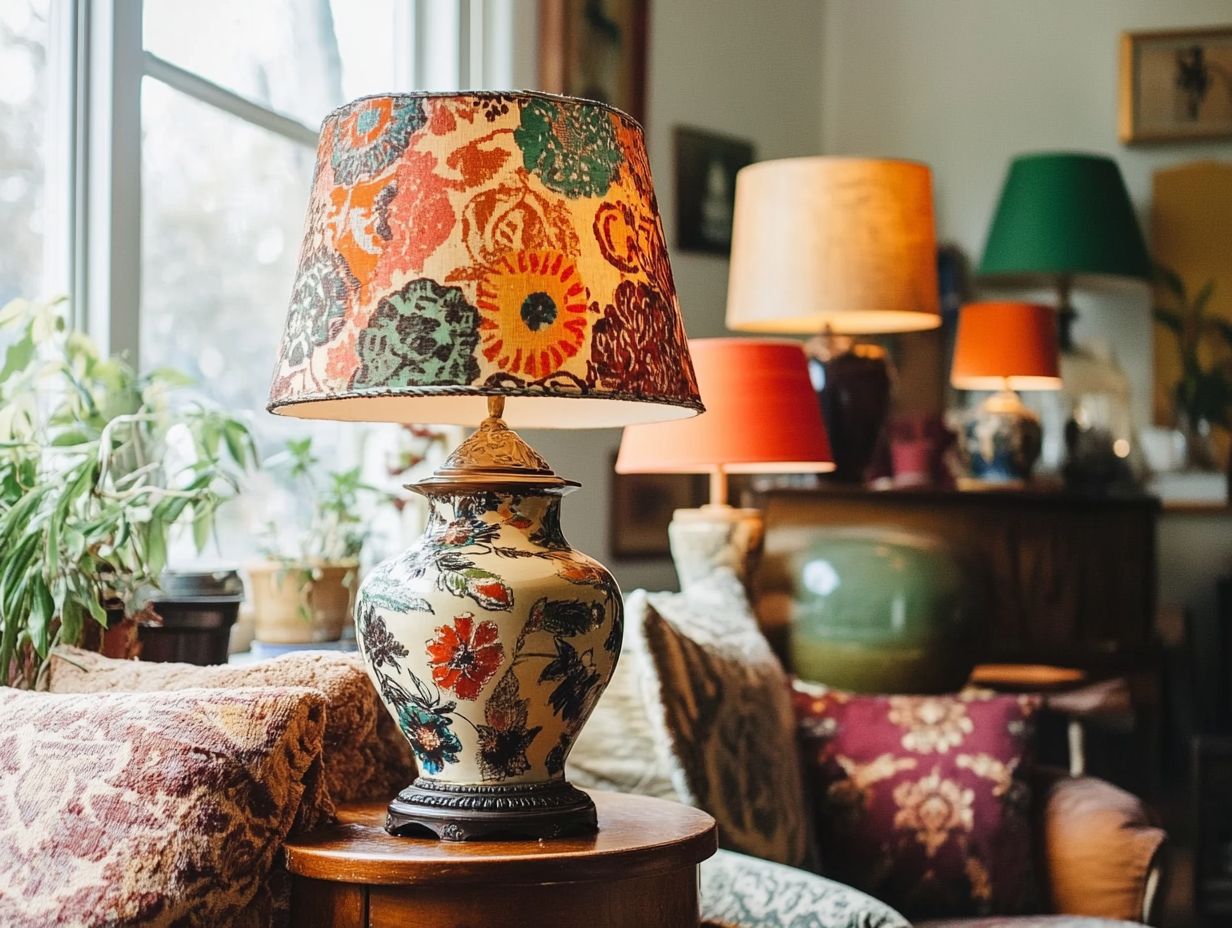
When choosing a shade for your vintage lamp, such as a tapered shade or a round shade, think about the size and shape of the lamp base. Also consider the style and era of the lamp, the type of shade material used, and the overall aesthetic you want to achieve.
What size shade should I choose for my vintage lamp?
The size of the shade should be proportionate to the lamp base. A general rule of thumb is for the shade to be about two-thirds the height of the lamp base. However, this can vary depending on personal preference and the style of the lamp, whether it’s a table lamp or a floor lamp.
What shape of shade is best for a vintage lamp?
The shape of the shade should complement the lamp base. For example, a round base would look best with a round or empire-shaped shade. A square base would pair well with a square or rectangular shade.
The style of the lamp, such as a chandelier or a sconce (a wall-mounted light fixture), should also be considered when choosing the shape of the shade.
What materials are commonly used for vintage lamp shades?
Some common shade materials include linen lampshade, silk, fabric, parchment, mica, and glass. Each material gives a different look and feel to the lamp, so choose one that fits the overall aesthetic you want to achieve.
Should I match the shade color to my vintage lamp?
Matching the shade color to your vintage lamp is not necessary. Choosing a complementary or contrasting color adds interest and depth.
If you prefer a cohesive look, opt for an empire lampshade that matches your lamp’s color.
Can I mix and match different shades for my vintage lamp?
Absolutely! Mixing different shades, like a drum lampshade which is cylindrical and a bell shade which flares out at the bottom creates a unique and eclectic look.
Just ensure the shades complement each other and the lamp base. Consider their size and shape for a harmonious appearance.

